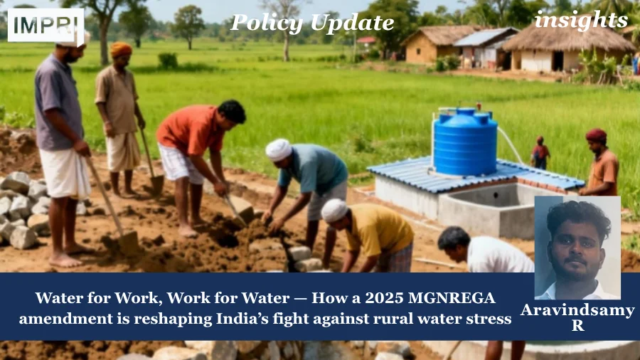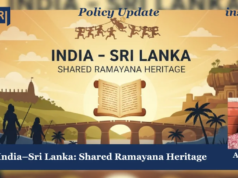Policy Update
Aravindsamy R
Background
Water scarcity has emerged as one of the most pressing developmental challenges confronting India. According to NITI Aayog’s Composite Water Management Index (2019), nearly 600 million Indians face high to extreme water stress, with demand projected to exceed supply by 2030. In rural India, where livelihoods depend heavily on agriculture, this crisis directly affects income stability, food security, and migration patterns.
The Mahatma Gandhi National Rural Employment Guarantee Act (MGNREGA), enacted in 2005, guarantees 100 days of wage employment to rural households and has evolved as a key instrument for sustainable rural development. Over the years, around 60% of MGNREGA works have focused on natural resource management, including water conservation, afforestation, and soil improvement. However, uneven implementation and limited targeting have constrained its full potential to combat water stress in vulnerable areas.
Recognizing these gaps, the Ministry of Rural Development (MoRD) introduced a policy amendment in 2025 mandating a higher proportion of MGNREGA funds to be earmarked for water conservation and harvesting activities in notified water-stressed blocks. This aligns with the government’s long-term strategy of integrating livelihood support with climate resilience and resource security.
Functioning
The amendment revises MGNREGA’s expenditure pattern to ensure at least 70% of total annual outlays in notified blocks are devoted to water-related works such as:
- Check dams, percolation tanks, and farm ponds.
- Renovation of traditional water bodies.
- Groundwater recharge and contour bunding.
- Drought-proofing and afforestation efforts.
Implementation of this scheme is guided by a block-level water stress index, developed jointly by the Central Ground Water Board (CGWB) and the National Remote Sensing Centre (NRSC) using real-time hydrological and rainfall data. The District Programme Coordinator (DPC) and Block Development Officer (BDO) are mandated to prioritize projects based on this classification.
Further, the GeoMGNREGA platform and JalDoot app have been integrated for digital monitoring of works, enabling real-time geo-tagging, progress tracking, and groundwater impact assessment. Funds flow through the Public Financial Management System (PFMS) to ensure transparency and timely wage payments.
The Union Budget 2025–26 has allocated ₹86,000 crore for MGNREGA. Under the new policy amendment, notified water-stressed blocks must earmark a fixed proportion of this expenditure for water conservation: 65% in over-exploited and critical blocks, 40% in semi-critical blocks, and 30% in safe zones. This financial reorientation ensures that nearly ₹35,000 crore of the annual allocation is channelled toward water conservation and related works. The funding pattern strengthens the government’s goal of linking wage employment with climate resilience and water sustainability.
Performance
Preliminary data from the MGNREGA Management Information System (MIS) for FY 2025–26 indicate notable shifts in expenditure patterns.
- Over 145 districts across Rajasthan, Maharashtra, Tamil Nadu, and Karnataka have been designated as high water-stressed.
- Water-related works accounted for 68% of total MGNREGA expenditure, up from 53% in the previous fiscal year.
- The scheme generated 250 million person-days in water conservation projects, contributing significantly to rural employment during lean agricultural seasons.
States like Maharashtra and Telangana have reported improved groundwater levels in select regions following the implementation of this mandate. Collaboration between MGNREGA and the Atal Bhujal Yojana (Atal Jal) has further enhanced data sharing and scientific planning at the Gram Panchayat level.
Impact
The amendment is reshaping how rural development and natural resource management converge. Its impact can be assessed on three dimensions:
- Environmental Sustainability: Increased investments in water harvesting structures have led to visible improvements in groundwater recharge and soil moisture retention. Early assessments by the Central Ground Water Board show a 2–5% rise in pre-monsoon groundwater levels in pilot districts.
- Economic and Livelihood Security: Farmers have benefited from improved irrigation availability and reduced input costs. The expansion of water assets has also supported livestock rearing and secondary livelihoods such as fishery and horticulture.
- Social Inclusion and Empowerment: Women, who constitute nearly 54% of MGNREGA workers, have gained from stable employment and participatory planning in watershed projects. Local institutions, including Gram Sabhas, are actively involved in selecting and maintaining water assets.
Emerging Issues
Despite its promise, the amendment faces operational and institutional challenges:
- Regional Disparities: States with limited administrative capacity struggle to plan and execute water projects effectively, leading to uneven outcomes.
- Data Gaps and Monitoring: Inadequate hydrological data at the block level hampers accurate water stress classification and project prioritization.
- Delayed Fund Disbursement: Wage arrears and delayed material payments continue to disrupt timely implementation.
- Skill and Technical Shortage: Many local implementing agencies lack trained engineers and watershed specialists to design technically sound projects.
- Asset Maintenance: Without post-construction maintenance plans, many structures risk becoming non-functional after a few years.
Way Forward
To sustain the momentum, the government must adopt a more integrated and evidence-driven approach:
- Convergence Frameworks: Strengthen coordination between MGNREGA, Atal Jal, Jal Shakti Abhiyan, and PM Krishi Sinchai Yojana for shared data and resource mapping.
- Decentralized Water Planning: Encourage Gram Panchayats to create localized water security plans with technical guidance from state agencies.
- Digital and Remote Sensing Tools: Expand the use of satellite-based monitoring and AI-enabled platforms for evaluating asset quality and water impact.
- Capacity Building: Train Panchayat-level functionaries and field engineers on watershed design, hydrology, and participatory planning.
- Community Ownership: Introduce user committees for the long-term maintenance of water assets, ensuring accountability and sustainability.
Suggestions
- Incentivize Performance: Introduce performance-based grants for districts demonstrating measurable groundwater improvement.
- Institutionalize Impact Audits: Mandate annual “Water Impact Assessments” under MGNREGA to track hydrological outcomes and guide future investments.
- Gender Mainstreaming: Encourage women-led water management committees to strengthen inclusive governance.
- Leverage Green Bonds: Explore financing models such as rural resilience bonds to mobilize additional resources for water conservation.
- Policy Synergy: Integrate water conservation targets within state climate action plans and agricultural development missions.
References
- Government of India. (2025, September 23). Notification on amendment to Schedule I of the Mahatma Gandhi National Rural Employment Guarantee Act, 2005, regarding expenditure for water conservation in water-stressed blocks. Ministry of Rural Development. https://rural.nic.in
- Government of India. (2025, September 24). National Initiative on Water Security launched by the Ministry of Jal Shakti and the Ministry of Rural Development. Press Information Bureau. https://pib.gov.in
- Ministry of Rural Development. (2025). MGNREGA Operational Guidelines (2025 Edition). Government of India. https://nrega.nic.in
- Central Ground Water Board. (2024). Dynamic Ground Water Resources Assessment of India. Ministry of Jal Shakti. https://cgwb.gov.in
- Ministry of Rural Development. (2025). Annual Performance Report on MGNREGA FY 2024–25. Government of India. https://nrega.nic.in
About the Contributor
Aravindsamy R is a public policy researcher at the Council of Independent Policy Researchers (CIPR) and a Research Intern at the IMPRI Impact and Policy Research Institute, New Delhi. He holds a Master’s in Public Administration from the University of Madras, with research interests in rural development, Public policy, and social protection policies.
Acknowledgement
The author extends his sincere gratitude to the IMPRI team and Ms. Aasthaba Jadeja for her invaluable guidance throughout the process.
Disclaimer
All views expressed in the article belong solely to the author and not necessarily to the organisation.
Read More at IMPRI:
Modernising The Coastal Shipping Framework: Coastal Shipping Bill, 2025



















